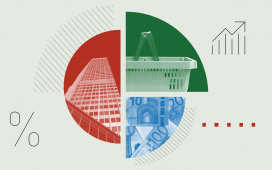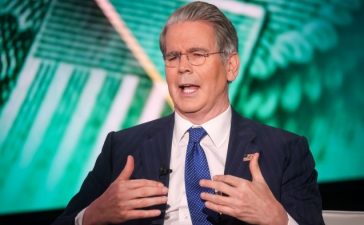Good morning. Nuclear energy stocks have soared to record highs on the back of big tech’s demand for green energy. Will this be the start of a new chapter for the technology? Or will regulation, accidents, and popular opionion get in the way? To adapt J. Robert Oppenheimer’s quoting of the Bhagavad Gita: “I am become uncertainty, ruler of markets.” Email us: robert.armstrong@ft.com and aiden.reiter@ft.com.
Soft landing vs no landing
Recently there has been some debate across the financial-economic punditocracy about whether we are experiencing a “soft landing” or a “no landing” scenario. In a soft landing, growth slows but recession is avoided, while inflation returns to a low and stable level. In a no landing scenario, growth doesn’t slow and inflation remains either a worry — volatile, and not quite down to target — or an outright problem.
The difference matters. In a no landing scenario, the Fed has to keep the policy rate relatively high, which squeezes the rate sensitive and cyclical parts of the economy, as well as indebted consumers. Anyone who owns longer-duration fixed income is likely to feel some pain, and in equities, sectors with inflation-hedging characteristics — materials, for example — will do better.
For a long time Unhedged has felt very confident that growth was falling gently and inflation was all but over with. Even just a few weeks ago, we were pretty dismissive about the odds of no landing. But our confidence, it pains us to admit, is wavering a bit. And it appears we are not alone. In the latest Bank of America fund manager survey, no landing remains a tail risk, but the tail is twice as wide as it was a month ago:

A summary of the recent growth data that is forcing this rethink:
-
September’s stronger jobs report.
-
September’s strong retail report, which showed 5 per cent annualised growth and cemented an accelerating pattern: the three month average rate is now higher than the six month rate, which is higher than the 12 month rate.
-
What we heard in the big banks’ earnings reports. JPMorgan’s CFO: “spending patterns [are] solid and consistent with the narrative that the consumer is on solid footing and consistent with the strong labour market and the current central case of a kind of no-landing scenario economically”; Bank of America CEO “[Consumer] payments were up 4 to 5 per cent year-over-year. The pace of year-to-year money movement has been steady since late summer . . . this activity is consistent with how customers are spending money in the 2016 to 2019 timeframe when the economy was growing, inflation was under control.”
-
Wages are growing at a 4 per cent clip that has not slowed since April.
-
Markets’ increasing bullishness, which both reflects the economic growth and contributes to it.
On the inflation side, there are a million ways to cut the data, but it is pretty clear that progress on inflation has slowed significantly; we have been stuck at 2.5 or 3 per cent for a few months now. Over at The Overshoot, Matt Klein gathers the various measures of CPI inflation with volatile components removed, and shows that 2024 looks a lot like 2023:

PCE inflation, which the Fed cares most about, is a bit better, but also appears to be stabilising a bit above target. The New York Fed’s model for the trend in PCE inflation is at 2.6 per cent:

Unhedged remains in the soft landing/inflation is over camp, and can point to various factors on both the growth side (manufacturing, housing, small business confidence) and the inflation side (shelter inflation finally coming down) to offset the uncomfortable warmth of recent data points. More importantly, zooming out, it simply makes sense that the economy should slow and inflation cool as we approach the five-year anniversary of the pandemic, especially in the context of a world economy that’s not all that great. There is no denying, however, that very recent trends are not supportive of this picture.
Prediction markets
According to cryptocurrency-based prediction exchange Polymarket, Trump’s odds of winning in a few weeks are 60 per cent, while Harris is hovering around 40 — a much bigger lead than the neck-and-neck swing state polls would have you believe. Other popular US prediction markets PredictIt and Kalshi also show Trump ahead, but by a smaller margin.

Are election prediction markets accurate? Early iterations in the US were often on the mark, according to a historical study by Paul Rhode at the University of Michigan, predicting the winner of the US presidential race 11 times out of 15 in the late 19th and early 20th centuries. But election markets have been more or less banned in the US since the 1940s — this election will be the first in decades with tacit federal approval for elections futures exchanges.
A better way of asking the question is: are the markets more accurate than polls-based models, like those put out by 538 and The Economist? We’d like to believe that markets know better, but the evidence is mixed. In a recent study, elections-betting expert Rajiv Sethi at Barnard College built virtual traders that mimicked the polls-based models, in order to see their profitability relative to other market participants. Sethi found that his virtual traders did relatively well, suggesting that the polls are at least as prescient as the election market consensus.
But as Sethi pointed out to Unhedged, “forecasting accuracy is incidental to the business model” for these exchanges. Stocks’ valuations are supposed to represent underlying value and future cash flows, but are pulled around by hype cycles, market narratives, and short-term traders. Election prediction markets have all that too, and some additional structural problems that could make them even worse. They are not particularly liquid; according to reporting by our colleagues, $30M in trades by four accounts helped swing Polymarket’s US elections market by up to 10 points this month. Plus the market participants are not particularly representative of the electoral base. According to Justin Wolfers at the University of Michigan, bettors on these exchanges are “more likely to be white, male, and Republican”, and the exchanges are not restricted to US voters.
That does not mean these markets are useless. They incorporate new information quickly. By asking “who will win” rather than polls’ “who will you vote for”, they may also prove a better read of the popular mood. And for traders, they offer a very straightforward hedge to a particularly unpredictable and consequential US election this year.
Due to their structural issues, and because they are still still new, we would not put too much credence in the absolute levels of the election markets in this cycle. But there is clearly some information in these nascent markets, and swings could be good directional indicators, provided they are not driven by just a few big bets.
(Reiter)
One good read
FT Unhedged podcast

Can’t get enough of Unhedged? Listen to our new podcast, for a 15-minute dive into the latest markets news and financial headlines, twice a week. Catch up on past editions of the newsletter here.









